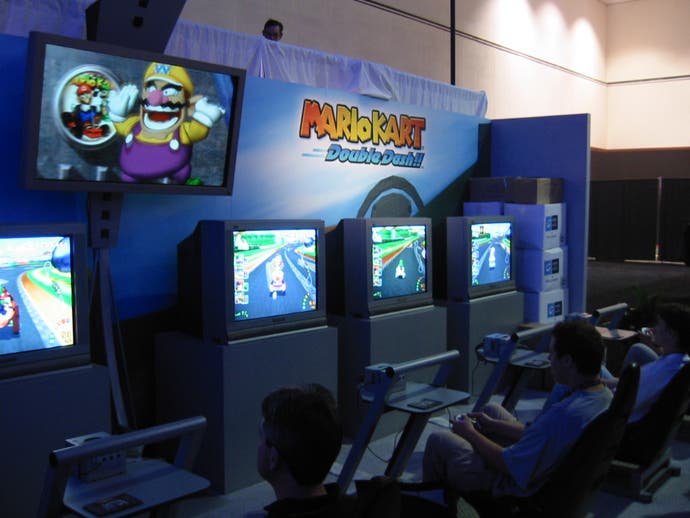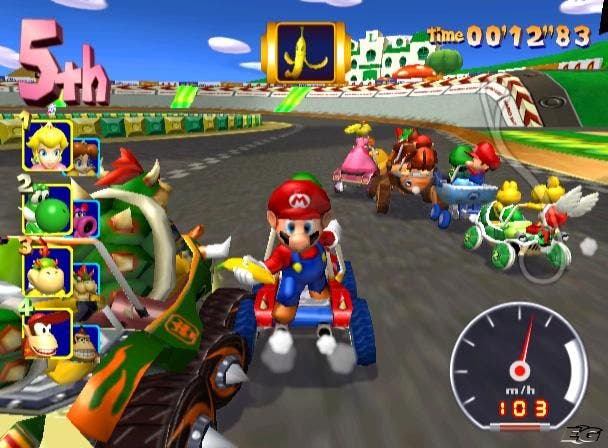E3 2003: Mario Kart Double Dash!!
Please get it right. Please please please...
Believe it or not, it's been more than five years since Mario Kart 64. When Nintendo first showed off a tech demo featuring Mario and Luigi karting (which, in retrospect, looks nothing like the nearly-finished article), we'd already been waiting more than three. In other words, it's safe to say that Mario Kart Double Dash has been a long time coming, and given that MK64 failed to set the entire world on fire, it's safe to say that we have heady expectations for this one. It's got to be utterly fantastic - and it's getting there.
Network karting

Nintendo had Double Dash set up in two areas at the show. One had the game running in 100cc 1-4 player modes on a handful of standalone Cubes, and one had an eight Cube, eight player network, complete with driving seats, massive television sets, and a bit of colour commentary from Mario, Wario, and twin booth ladies. Not to mention a 15-minute queue throughout the day.
In short, it feels a lot like Mario Kart. There have been several changes to the formula, some more obvious than others, but anybody with two thumbs and a cerebral cortex should be able to pick it up in no time at all. The game is controlled as ever with acceleration (A), brake (B), power-up (Y/X - same function) and slide buttons (left and right triggers). As you will have noticed, Double Dash has two characters per kart, so Z now enables you to switch them. You can no longer dangle a power-up behind you like a shield by holding Y or X, but to make up for this the new two-character dynamic allows you to stow one item away, as the chap on the back is the only one who ever throws anything. Another interesting change is that the slide function now totally replaces hopping, and sliding is a drift approach ala the SNES and GBA versions, rather than the slightly more measured N64 alternative.
Obviously with sixteen characters (Mario, Luigi, Peach, Baby Mario, Baby Luigi, Yoshi, Birdo, Wario, Waluigi, Donkey Kong, Diddy Kong, Bowser, Bowser Jr., Koopa, and Paratroopa - phew - and potentially more as unlockable extras, like the eerily absent Toad), two to a kart and the ability to pick your own vessel, the question of what actually affects top speed, acceleration and other attributes is difficult to answer, but after several hours of experimentation and being thrown off the stand (by colourfully dressed women at least), we've established that karts seem to be the key. Mario's streamlined hotrod makes a big difference compared to, say, Donkey Kong's reconstituted barrel, and although you may fancy big burly characters to muscle your way around the track, you can't fit Wario into Baby Mario's pram, for example, so there's quite a lot of strategy to consider. And of course with eight or even just four players and sixteen characters, it's a bit of a free for all on the character select screen.
Power to the people
As is fitting for the next step in the series, there are more power-ups, and some of them are character-specific. Old favourites like mushrooms, green and red shells and bananas (all of which come in packs of one and three) return alongside some bouncing fireballs and a winged variation on the blue shell, which now dive-bombs the leader of the race with a massive explosion radius that engulfs anybody foolish enough to venture too close. And as I said, specific characters get new, super-sized versions of their old familiars - Donkey Kong, for example, gets a giant banana, with a giant shell for Bowser to boot. There was also a new Bowow power-up that drags you along on a chain for a while, before breaking off and scampering along munching anything in its path, but this might not have been character-specific. It was a sight to behold the first time someone used it against us, mind.
Stripped from the power-up list (or so it seems) is the Ghost item, which seems to have been replaced by the ability to swipe items from other racers by bashing into them and clawing shells and bananas right out of their greedy paws (pick-pocketing little gutter snipes!). Shells of course remain the bane of most players' existence, but we're told that there will be a couple of evasion moves in the final game to redress the balance - allowing you to dodge red shells at the last moment if you're quick-fingered enough, and recover from banana slides in a similar manner.
Double Dashing

Visually, the game is absolutely gorgeous. We were sceptical about the first screenshots, but as with pretty much anything that comes out of Nintendo these days, the first time you clap eyes on it in motion all past sins are quickly forgotten. The first thing that strikes you is the definition and clarity of the whole thing - the sharp yet cartoony texturing, the immense draw distance, the smooth framerate and a level of detail that admittedly owes a lot to the HDTVs we were playing it on. All the same, when it looks this sharp and there are no visible LOD effects (like geometry dechunkifying at a distance) you know it's good.
The characters all have neat little individual animations, swinging around one another seamlessly when you hit Z, throwing items in the direction you send them, juggling them in the back, leaning out of the kart, pushing it along like a bobsled to get it going and even dangling out of the back by the tips of their fingers when airborne. The karts too bump around like nobody's business and have this sort of rickety charm to them, their wheels turn properly, and when they take a hit they fly up in the air then tumble to earth and bounce from wheel to wheel. But it's when you're miniaturised by someone's lightning power-up that the detail really strikes you - they look so neat even when they're shrunk to the size of a pea.
The tracks are the real revelation though. There were three in the demo; Luigi Grand Prix, DK Mountain and Mushroom City, and each has a new and distinctive yet familiar look and feel to them. Luigi GP is old school Mario Circuit stuff, with an asphalt track, grassy verges, lots of boost strips (some up on neighbouring banks) and a big Bowow on a leash to snap at the players' heels. DK Mountain is a fantastic up and down mountain track, where you clamber up a sort of reverse slalom and into a barrel cannon, which sends you soaring to the top of a grumpy-looking mountain that you subsequently coast down (taking a bumpy shortcut if you fancy) before rounding some tight bends, avoiding broken sections of railing, a crumbling cliff face and giant boulders, and finally racing across a swinging rope bridge towards the finish line. Meanwhile Mushroom City has you weaving through traffic, taking alternate routes to get where you're going and avoiding the occasional pitfall. They certainly all felt at home in the Mario Kart universe. The texturing on all three is very sharp (quite a feat considering the platform) and feels at home with its predecessors and the likes of Mario 64/Sunshine.
Addicts unite
At the moment, Mario Kart Double Dash is little more than a demo to us, with a few nice tracks and a feel borne out of the best bits of Mario Kart to date. We spent ages going round and round the queue to play in the eight-way matches, soaking up gameplay waxed smoother than a plumber's moustache for the show. Even though there are still some snags like missing features and getting caught on scenery, that's about the height of our concerns, because the racing model is as instantly addictive and continually surprising as ever. It would have been nice to see a battle mode at E3 (if only to demonstrate that it can work properly in 3D), but even in the absence of it it's clear that Mario Kart is back on the Rainbow Road to success, and with the game due out in the fourth quarter of this year, it's nearly time to buckle up.


.png?width=291&height=164&fit=crop&quality=80&format=jpg&auto=webp)




.jpg?width=291&height=164&fit=crop&quality=80&format=jpg&auto=webp)
